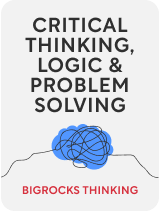

This article is an excerpt from the Shortform book guide to "Critical Thinking, Logic & Problem Solving" by Bigrocks Thinking. Shortform has the world's best summaries and analyses of books you should be reading.
Like this article? Sign up for a free trial here.
Do both sides of an argument warrant the same amount of consideration? What’s the difference between correlation and causation?
You’ve probably experienced this: You hear something that sounds great. But, when you think it through, it doesn’t make a whole lot of sense. A fallacy could be to blame. The more you know about fallacies, the better you’ll be able to evaluate information and arguments.
Continue reading for a brief overview of three different types of fallacies.
3 Types of Fallacies
The authors of Critical Thinking, Logic & Problem Solving advise that you assess your information for fallacious logic and be on the lookout for fallacies in your own logic as well. A fallacy is a misunderstanding that interferes with your reasoning. They discuss different types of fallacies that are fairly common.
(Shortform note: While a fallacy is indicative of a flaw in reasoning, it doesn’t necessarily prove an argument’s conclusion is false. Someone may use a fallacy to make a claim or come to a conclusion that is correct, so while it’s important to spot fallacies and avoid them yourself, don’t assume that a claim backed up by a fallacy is automatically false—this assumption is actually a fallacy as well, known as the fallacy fallacy.)
Let’s explore three different types of fallacies you’re likely to run into.
#1: Middle Ground Fallacy
The middle ground fallacy is when there are two opposite options and you assume that the compromise between the two must be correct. However, if either of the opposite options is incorrect, then the middle ground will also be incorrect.
(Shortform note: The middle ground fallacy, also called the false compromise fallacy or bothsiderism, comes from the belief that both sides of an argument deserve equal consideration. However, this becomes problematic when the two opposing sides aren’t equally valid. One of the clearest illustrations of this is when the argument revolves around a question with an obviously correct answer, such as “Is Nazism bad?” To paint both sides of this argument as equally valid (suggesting that “Nazism is bad” is as accurate a claim as “Nazism is good”) is fallacious because one side relies on the dehumanization of large groups of people, and seeking a middle ground in this argument gives undue credence to that side.)

———End of Preview———
Like what you just read? Read the rest of the world's best book summary and analysis of Bigrocks Thinking's "Critical Thinking, Logic & Problem Solving" at Shortform.
Here's what you'll find in our full Critical Thinking, Logic & Problem Solving summary:
- A step-by-step guide for improving critical thinking and problem-solving skills
- Tips for conducting better research and finding reliable resources
- How to improve your communication and storytelling skills






